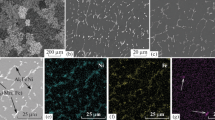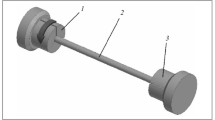Abstract
Structural superplasticity in two phase alloys of the copper-nickel-zinc system (nominal composition in wt. pct Cu-15Ni-38 Zn-0.2 Mn) occurs over a wide range of strain rates in the temperature range 850 to 1050∮F (454 to 565°). The upper temperature limit for super-plastic behavior in this system is determined by the reversion of the fine-grained two-phase structure to a single phase structure in which extensive grain growth is possible. Residual room temperature tensile properties and microstructure of the microduplex alloy after superplastic straining have been studied as a function of test temperature and total super-plastic strain. At test temperatures sufficiently removed from the phase transformation temperature, the high tensile properties and fine microstructure of the starting material are essentially retained after superplastic strains approaching 200 pct. In the immediate vicinity of the phase transformation temperature, rapid degradation of the microduplex structure occurs during superplastic deformation with a consequent severe degradation of the residual room temperature tensile properties.
Similar content being viewed by others
References
G. J. Davies, J. W. Edington, C. P. Cutter, and K. A. Padmanabdan:J. Mater. Sci., 1970, vol. S, p. 1091.
R. H. Johnson:Met. Rev., 1970, no. 146, p. 115.
T. Y. M. Al-Naib and J. C. Duncan:Int. J. Mech. Sci, 1970, vol. 12, p. 463.
G. H. Reynolds and R. D. Schelleng:Met. Trans., 1972, vol. 3, p. 1837.
G. 0. Aubakipov, A. A. Presnyakov, and K. T. Chernausov:Izv. Akad. Nauk SSR, Metalfy, 1969, vol. 4, p. 246.
M. Stamford:Copper, 1969, vol. 3, p. 10.
D. M. R. Taplin and S. Sagat:Mater. Sci. Eng., 1972, vol. 9, p. 53.
D. M. R. Taplin, G. L. Dunlop, S. Sagat, and R. H. Johnson:Proceedings of the II Inter-American Conference on Materials Technology, Mexico City, 1969, ASME, New York, 1970, p. 253.
H. W. Hayden, R. C. Gibson, H. F. Merrick, and J. H. Brophy:Trans. ASM, 1967, vol. 60, p. 3.
W. A. Backofen, 1. R. Turner, and D. H. Avery:Trans. ASM, 1964, vol. 57, p. 980.
E. F. Nippes and W. F. Savage:Weld. J., 1949, vol. 28, no. 11, pp. 534–35.
J. Schramm:Kupfer-Nicket-Zinc Legeiningen, Wurzburg, Konrad Triltsch, 1935.
R. T. DeHoff and A. G. Guy: University of Florida, Gainesville, Florida, unpublished research, ONR Contract Report No. N00014-68-A-0173-0011.
H. W. Hayden, S. Floreen, and P. D. Goodell:Met. Trans., 1972, vol. 3, p. 833.
Author information
Authors and Affiliations
Additional information
Formerly with The International Nickel Company, is now with Gulf Energy and Environmental Systems, Materials Science Department, P. O. Box 608, San Diego, Calif. 92112.
Rights and permissions
About this article
Cite this article
Schelleng, R.D., Reynolds, G.H. Superplasticity and residual tensile properties of a microduplex copper-nickel-zinc alloy. Metall Trans 4, 2199–2203 (1973). https://doi.org/10.1007/BF02643288
Received:
Issue Date:
DOI: https://doi.org/10.1007/BF02643288




